Continuing from my last post on identifying our common oak trees, let's this month look at some of the insect
and disease problems that can infest oak trees. We have many large oak trees here in Pinellas County and there are several
problems that you may notice in the spring or throughout the year. Most are not life threatening for the oak and are
mere curiosities, but borers can be a sign of deeper problems.
Oak
leaf blister (Taphrina caerulescens) is a fungus that commonly attacks Oaks
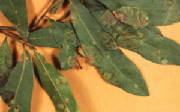
in the spring when we have had cooler and wetter than normal weather as we have had this spring.
This fungal pathogen causes raised or wrinkled blisters on new leaves that are initially pale green, but will turn brown later
in the season. It is unsightly, but usually not treated with fungicides unless there is a severe infection on a newly planted
young tree. Rake and discard fallen leaves from under infected trees to reduce the disease organisms for the following year.
The leaf rolling weevil (Homoeolabus analis) attacks oaks in our area by
creating

individual nests (nidi) for its eggs using leaves rolled into a tight bundle that looks like a miniature
egg roll. The bundle is then either cut away to fall to the ground, or it remains attached to the leaf base on the tree.
I find these strange nests scattered on my wooden deck under my live oak tree. The adult weevils feed by chewing small
holes in the leaves in addition to the leaves that are damaged by construction of the nidi. The weevils do not cause
significant damage to trees, so control is not necessary.
Psocids (Archipsocus
nomas) are small insects that congregate on tree trunks or

branches. The whole group of insects are often covered with a tight silk webbing, which could be the
first sign noticed. The insects are quite small (about ¼ inch), and the adults have wings. They cause no harm
to the trees, instead they feed on debris such as lichens, fungi, and pollen found on the bark.
There are a number of different caterpillars that attack oaks, including: eastern tent, fall
webworm, tussock moth, and leaf rollers. Look for caterpillars hanging from silk strands, grouped in webs, or crawling up
tree trunks shortly after leaf emergence in the spring. Caterpillars feed on the foliage, causing holes or jagged edges in
leaves and the pellets of frass (fecal material) can be seen on surfaces underneath trees. Eastern tent caterpillars
make webs in the crotches of branches. Other types of caterpillars may be identified by color patterns and by unique tufts
of hairs. Natural enemies and unfavorable weather conditions usually keep populations low. Outbreaks do occur, but usually
last only one to two years. Remove and destroy tents of eastern tent caterpillars when first noticed.
Insect-induced galls occur in many forms, colors and shapes. They may be hair-

like projections, spheres, rosettes or woody swellings and can occur on leaves or twigs or branches. The
malformed plant tissue, or gall, forms in response to egg-laying or feeding by wasps, midges, mites, moths, aphids or beetles.
The young insects develop inside the gall, but cause little or no damage to the tree. Small exit holes on the outside of the
gall indicate that the insects have already emerged, but the gall remains.
There are many
of different borers that affect oaks. They can be detected by
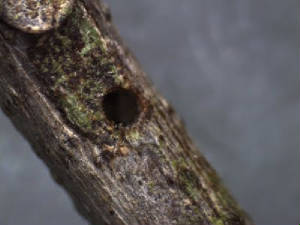
looking for symptoms such as foliage discoloration, wilting, branch dieback, and small holes in the trunk
of the tree. You could also observe woodpeckers feeding on the bark. Examination of the trunk may reveal sap staining
and sawdust or pellets on the bark. By carefully removing the bark around the borer holes, you can see the tunneling caused
by the larval stages of the beetles. Trees affected by borers are generally weakened or wounded by some other factor
such as root rot, soil disturbance, drought, flooding, or physical injuries to trunk or branches. To avoid infestations,
keep trees healthy. Remove and destroy severely infested trees, or prune out dead and dying branches. Once a tree is infested,
little can be done. An arborist can temporarily protect other nearby trees with approved insecticides applied to the trunk
from spring to fall.
All photos are from University of Florida publications
When you first notice them, a majestic Live Oak and a Laurel Oak may look like the same tree, but there
are some important differences that could be very important to you and your landscape over the years. Both are Florida native
trees.
First let's look at the characteristics of each tree:
Live Oak, Quercus
virginiana is a large, sprawling, tree that grows to a mature

height of 60 to 80 feet with a wide spreading canopy of 60 to 120 feet. It develops very strong wood
that is quite resistant to decay. These trees can live for 300 years or more, are very tolerant to drought and are somewhat
tolerant of salt. The leaves of the Live Oak have smooth edges that are sometimes
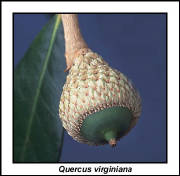
toothed and are a lustrous green on top and pale green with very
fine fuzz on the underside. Live Oaks will retain leaves until after the next year's foliage starts to emerge, making it a
true evergreen. Clusters of three to five acorns are found on long stalks attached to twigs. The mature bark is a deep red-brown
and slightly furrowed vertically.
Laurel Oak, Quercus
laurifolia is a tall, broad tree that
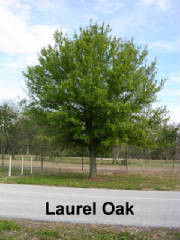
grows to a height of 60 or more feet with a fairly symmetrical oval canopy spread of 40 to 60 feet.
The fast growth rate results in relatively weak wood that is prone to break and decay. Laurel Oaks have a lifespan of 50 to
70 years when grown in ideal conditions, but 30 years is more common in
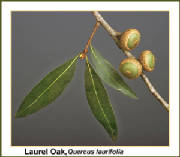
urban plantings. These trees are moderately drought tolerant and have a low salt tolerance. The leaves
of the Laurel Oak are smooth, narrow, shiny green on top and pale underneath with a yellow midrib. The margins of the leaves
are either smooth or irregularly lobed. All of the previous year's leaves usually are shed in the early spring before
the tree blooms and new leaves sprout. Acorns are about one half inch long and found singly attached directly to the
twig. The bark is a dark reddish-brown that becomes deeply fissured with age.
Now, why is this important for you and your landscape? Research at the University
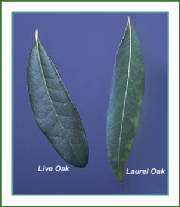
 of Florida has shown that the Laurel Oak is very prone to failure in hurricane winds due to the weak wood and their tendency to decay. These
trees may not be appropriate to plant near a home or other structure. Deep roots and a relatively short height in relation
to crown spread, along with strong wood help the Live Oak withstand the high winds and strong storm surges that can bring trees down during hurricanes. For research details
that include most tree varieties: http://hort.ifas.ufl.edu/woody/documents/FR173.pdf.
of Florida has shown that the Laurel Oak is very prone to failure in hurricane winds due to the weak wood and their tendency to decay. These
trees may not be appropriate to plant near a home or other structure. Deep roots and a relatively short height in relation
to crown spread, along with strong wood help the Live Oak withstand the high winds and strong storm surges that can bring trees down during hurricanes. For research details
that include most tree varieties: http://hort.ifas.ufl.edu/woody/documents/FR173.pdf. To
complicate this issue, many oaks that are grown from acorns could be hybrids or crosses of the laurel oak and live oak that
show some characteristics of both species. If you are going to plant an oak and you want a live oak, it is probably
best to pay a bit more for the tree and purchase one of the cloned live oak varieties available to insure that you are planting
a true live oak. ‘Cathedral' and ‘Highrise' are two cloned cultivars that are available in Florida.
These clones also tend to grow straighter trunks and not spread the canopy as much as wild live oaks.
Another tree that you will see is the Sand Live Oak, Quercus geminata.
It is another evergreen or live oak that is a good bit smaller than Quercus virginiana. This oak grows in the dry sandy soils of coastal dunes,
hardwood forests, mixed pine uplands, scrub, and sandhills. Many of the oak trees that you see in Safety Harbor are
sand live oaks. Sand live oaks grow best in partial shade to full sun and generally will slowly reach 50 feet tall. The
thick, leathery leaves range from 1½ to 2½ inches long. They are elliptical in shape with coarse veins and smooth
margins that curl inward creating a cup-like appearance. This makes the individual leaves look like little boats.
The upper surface of the leaf is dark green and the underside is a dull gray to almost whitish color. The bark is rough
to the touch, dark brown, and deeply furrowed. Acorns are produced annually and appear in groups of 1 to 3 in the fall.
Pictures by Larry Korhnak, University of Florida
Mature Laurel Oak picture by Pam Brown

